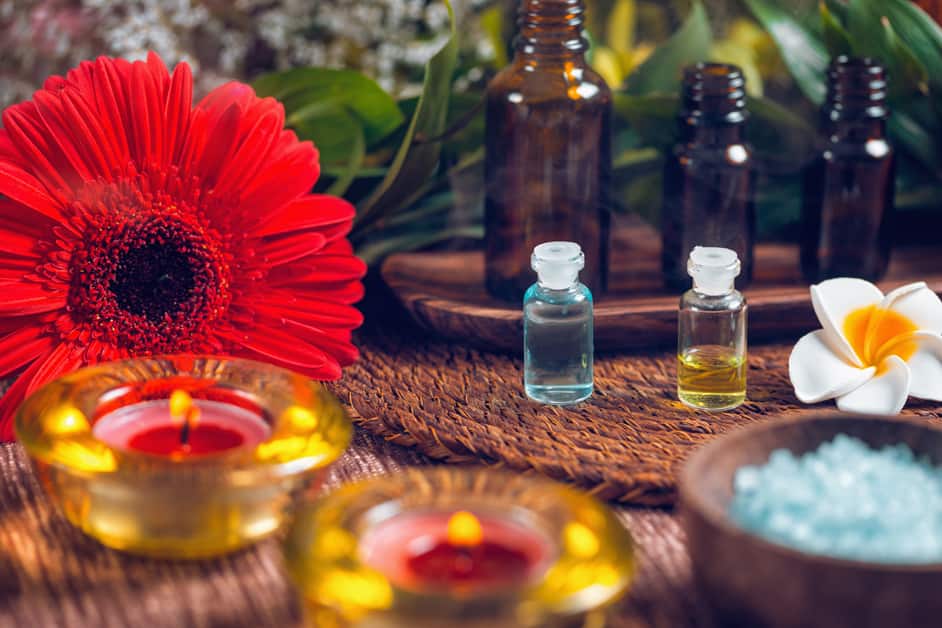Introduction
Aromatherapy is an alternative medicine that uses essential oils and fragrances to boost mental and physical well-being. It has been used for centuries to reduce pain and stress. Especially, it can help reduce knee pain.
Essential oils are taken from plants and herbs, usually with steam distillation. They can be used in many ways – applied directly on the skin or inhaled via aromatherapy diffusers. Consult a healthcare professional for best results when combining aromatherapy with other treatments or lifestyle changes.
Choosing the right essential oil for knee pain relief depends on how active you are and if you want long-term results or just temporary relief. Some essential oils are calming, while others are better for quick relief without disrupting your daily activities. Here we explore some essential oils that may help against certain types of knee pain when combined with treatments and lifestyle changes:
What is Aromatherapy?
Aromatherapy is a type of healing that uses plant extracts, known as essential oils, to better physical and emotional health. When these oils are inhaled, the brain produces hormones and chemicals that reduce pain and create relaxation. This makes aromatherapy a great way to lessen knee pain.
Essential oils have been used for a long time in many cultures. But, it was only in the 1930s that French perfumers managed to isolate the distinctive compounds in these fragrances. After that, various scientific studies showed that specific combinations of essential oils could help against different physical and mental issues, including knee pain.
If used correctly, and with the right amount of caution, aromatherapy can bring relief from knee pain, as well as lower stress levels and create a feeling of happiness. Some of the best essential oils for knee pain are:
- Lavender
- Eucalyptus
- Peppermint
- Wintergreen
- Chamomile
- Patchouli
- Rosemary
- Ginger
Each oil has specific properties that can bring healing when used in the right way.
Benefits of Aromatherapy for Knee Pain Relief
Aromatherapy is using essential oils from plants to help healing. These oils have properties like reducing inflammation and pain, so they are good for those with chronic knee issues. When used in combination with other natural remedies like massage or physical therapy, it can help with inflammation, stiffness, and pain.
Caution must be taken with essential oils, as they are potent substances. Consult a certified aromatherapist or doctor before attempting any home use. To get the best results, use a high-quality, therapeutic-grade oil and follow it up with simple stretches or a gentle massage.
Benefits of Aromatherapy for Knee Pain Relief: Aromatherapy can reduce swelling and inflammation, as well as give pain relief from arthritis or other chronic knee problems. It also improves circulation, speeding up healing by increasing nutrient flow. Other benefits include feeling better, more relaxed, improved sleep, less anxiety, and better general wellbeing.
Essential Oils to Try for Knee Pain Relief: Essential oils may help reduce inflammation, promote healing, and reduce joint discomfort associated with knee pain. Some of these oils are:
- Lavender oil (Lavandula angustifolia)
- Geranium oil (Pelargonium graveolens)
- Juniper Berry oil (Juniperus communis)
- Eucalyptus oil (Eucalyptus globulus)
- Rosemary oil (Rosmarinus officinalis)
Essential Oils to Try
Aromatherapy is a terrific way to get natural relief from knee pain. Essential oils have been utilized by many cultures for centuries to treat different issues. In this piece, we shall examine which essential oils are the best for knee pain relief and how to utilize them securely.
Lavender Oil
Lavender oil is a popular essential oil, perfect for aromatherapy. It has a calming scent that can help reduce stress and anxiety. Plus, it can be used topically to improve wound healing, reduce inflammation, and provide relief from joint pain.
Mix a few drops of lavender oil with jojoba or coconut oil for a topical treatment. This can help improve joint mobility.
Inhalation is the most common way to enjoy the therapeutic benefits of lavender oil. Put a few drops on a cloth or tissue, and hold it near your nose while inhaling deeply. This is a great way to relax your muscles before physical activity that could cause knee tension or strain.
Peppermint Oil
Peppermint Oil is a popular essential oil for knee pain. It contains menthol, which can help relieve joint pain. It also has muscle-relaxing and anti-inflammatory effects. This oil can reduce discomfort from sprains, muscle aches, bruises, minor injuries and arthritis. Plus, it’s aroma can reinvigorate tired and sore muscles. And, it can increase blood circulation in painful areas.
To use Peppermint Oil for knee pain, mix five or six drops with 30ml of a carrier oil such as jojoba or coconut oil. Then massage it into the affected area twice a day. But be careful! Essential oils may be strong and irritate sensitive skin if too much is used.
Eucalyptus Oil
Eucalyptus oil (Eucalyptus globulus) is extracted from the leaves of the tall eucalyptus tree native to Australia by steam distillation. Its aroma is woody and sweet, and it is used in many cosmetic, pharmaceutical and industrial products.
Diffusing or adding it to massage oils can bring about a refreshing atmosphere to enhance focus and alertness. It is thought that Eucalyptus can help with colds, coughs, congestion and sinus headaches. Inhaling its vapors can help clear mental fog and boost energy.
It can also be used to clean your environment as an all-purpose cleaner or applied directly to the skin to support healthy joints and muscles. Added to shampoo or body wash, Eucalyptus can nourish the scalp and promote hair growth. It can also eliminate odors in laundry detergent or air fresheners with its invigorating scent.
Safety precautions should be taken when using Eucalyptus essential oil. It should never be taken internally nor applied directly on children under 10 years old depending on their condition and severity of symptoms. Please consult your healthcare provider before using this oil, as it may have contraindications when combined with other medication.
Rosemary Oil
Rosemary oil is centuries old. It has anti-inflammatory properties that can help with physical pain and discomfort. Apply it to the knee to reduce swelling. Its scent also has restorative benefits on the skin and joints. It may also help with mental fatigue that often comes with chronic knee pain.
In aromatherapy or when applied topically, rosemary oil can act as a natural analgesic. It can help with minor aches and pains due to arthritis and other inflammatory conditions. But, get advice from a healthcare provider or aromatherapist before using it for serious health issues.
Ginger Oil
Ginger oil is known for easing inflammation and muscle pain. It can help with knee arthritis too, providing a warming sensation that relieves the ache. In aromatherapy, it has a subtle spicy aroma that enhances relaxation.
To use it topically, mix two drops of ginger oil with two tablespoons of a carrier oil and massage it into affected areas. Diffuse 10 drops of ginger oil in a diffuser, but do not over-heat it.
Ginger oil is generally safe, but it should be avoided if pregnant, breastfeeding, or taking medication. Excess use may irritate skin, so do a patch test before applying it to larger areas of the body.
How to Use Essential Oils for Knee Pain Relief
Aromatherapy can assist with pain management – specifically knee pain. Essential oils are useful for numerous types of pain, including knee pain. In this piece, we’ll review the advantages of aromatherapy for knee pain relief. Let’s look more closely into the potential gains!
Massage
Massage can help relieve knee pain. It reduces inflammation and boosts circulation – improving healing and reducing stiffness. Essential oil massage is an effective way to use aromatherapy and lessen pain. Here are some tips to ensure the best results:
- Get high-grade, safe and pure oils.
- Dilute the essential oil with a carrier oil like almond, jojoba or coconut oil. Use 5-10 drops of essential oil per ounce of carrier oil.
- Research the right ratio of oils for your condition.
- Always talk to a medical professional before trying any new remedies. Aromatherapy results can vary greatly depending on individual history and environmental conditions.
Compress
For relief from swollen and painful knees, try the compress method. Heat a small cloth sack with Epsom salt. Add 10 drops of essential oil blend. Place the compress on the sore knee. Trap in the heat by covering with another cloth sack. Elevate one leg while doing this regularly; morning or night. Do this for several days to reduce inflammation and discomfort.
Bath
Essential oils can be used for knee pain relief. But before you add them to a warm bath, make sure they are mixed with a base oil – like jojoba, almond or avocado oil. This diluting prevents skin irritation and makes the scent more pleasant. Epsom salt or baking soda can also be added. This helps soothe inflammation and relax aching muscles.
Give yourself some time to relax. Let the bath melt away your pain.
Inhalation
Inhalation is a great way to soothe knee pain with essential oils. You can smell the aroma directly from the bottle or use a diffuser. Inhaling the vapors can have both physical and mental effects.
Physically, the scents reach your brainstem through your micro-capillary veins. They interact with certain receptors and affect how your body responds to pain. Mentally, certain smells can evoke calming responses. They help reduce stress levels which makes pain more bearable.
Eucalyptus, lavender, peppermint and rosemary are known for their soothing and anti-inflammatory properties. They may aid in relieving knee pain. Additionally, these aromas can relax you and lessen stress levels. To get the most out of their therapeutic benefits, explore different combinations of essential oils or enjoy them on their own.
Safety Considerations
Take a moment to consider safety and usage when using essential oils. They are highly concentrated and can be damaging if not used properly. Dilute essential oils with a carrier oil when using them for knee pain relief. Five drops of essential oil to one teaspoon of carrier oil is a good ratio. Remember to avoid getting essential oils in the face, eyes, and nose, especially with hot or warming agents. Do a patch test before applying to larger areas.
Check with a healthcare provider prior to usage, as some treatments may not be suitable for certain medical conditions.
Conclusion
Aromatherapy can be a natural way to relieve knee pain. Essential oils used in this method are found in nature, and their healing powers can be strong. Consult a healthcare pro if you opt for aromatherapy to manage knee pain. Make sure it’s safe, effective, and properly administered.
When picking essential oils, consider the desired goal. Many manufacturers mix different oils in massage oils, as some of these may be too harsh to use alone. Dilute the oil with a carrier oil such as jojoba or almond before applying it to the skin. Use high-quality essential oils and remember: Dilute more than you think necessary when using them on the skin and respect them!
Frequently Asked Questions
Q: What essential oils are best for knee pain relief?
A: Lavender, peppermint, and eucalyptus oil are all essential oils that can provide knee pain relief. They can be used either in a topical form, such as a massage oil, or through aromatherapy.
Q: How do essential oils provide knee pain relief?
A: Essential oils have anti-inflammatory and pain-relieving properties that can help reduce swelling and discomfort associated with knee pain. They can also help improve circulation, which can further reduce pain and inflammation.
Q: How should essential oils be used for knee pain relief?
A: Essential oils can be used in a variety of ways for knee pain relief. They can be massaged directly into the affected area, added to a warm bath, or used in an aromatherapy diffuser.





